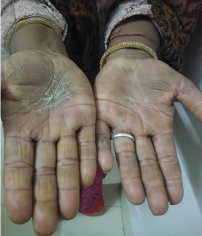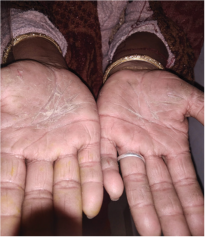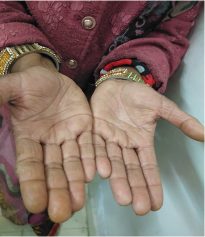Translate this page into:
Management of Palmar Dermatitis through Homoeopathy: A case report
*Corresponding author: Sangeeta Jain, Department of Anatomy, University College of Homoeopathy, Kekri, Ajmer, Rajasthan, India. arihanthomoeo25@gmail.com
-
Received: ,
Accepted: ,
How to cite this article: Jain S, Sharma M Management of palmar dermatitis through homoeopathy: A case report. J Intgr Stand Homoeopathy 2022;5:55-8.
Abstract
Palmar/hand dermatitis is a common, chronic and multifactorial disease. It is usually related to occupational or routine household activities. Its aetiology is difficult to determine in most cases and its treatment is challenging. It may become severe and disabling to many patients over time. We report the case of a 50-year-old woman who presented with palmar dermatitis, dryness and cracking of the skin of hands and itchy eruption on palms for 2 years. Based on individualisation according to the presenting totality (grief, despair, restlessness, sadness and aversion for bathing) and pathological diagnosis (dry and cracked skin of palm), Sulphur was prescribed in increasing potencies. The symptoms disappeared within 3 months and the patient reported that she felt relaxed, which had eluded her for 2 years. This case provides evidence supporting the effectiveness of individualised homoeopathic medicine in cases of palmar dermatitis.
Keywords
Palmar dermatitis
Individualised homoeopathy
Sulphur
INTRODUCTION
Palmar dermatitis is defined as dermatitis that is largely confined to the hands, with none or only minor involvement of other areas.[1] Palmar dermatitis is a very common and widespread condition; women are affected more, possibly because of increased exposure to water and household chemicals (e.g., in tasks such as washing utensils and clothes).[2] Health-care professionals, machinists, housekeepers and beauticians are other examples of individuals at a higher risk for developing symptoms.[3]
Hand dermatitis represents a large proportion of occupation-associated skin disease, with a prevalence of 2–9%.[4] Understanding each patient’s disease pattern and exacerbating factors are essential for effective diagnosis and management.[3]
CASE REPORT
Chief complaints
Patient has dry and cracked skin of the palms with intense itching for the past 2 years.
History of presenting illness
A 50-year-old woman reported to the outpatient department of Dr. Girendra Pal Homoeopathic Hospital on 24 December 2020, with complaints of dryness and intense itching with burning of the palms. She had observed redness and burning 2 years before, which had gradually increased in intensity. Allopathic treatment provided temporary relief, with severe aggravation later. Therefore, the patient decided to switch to homoeopathic treatment.
Patient as a person
The patient was a housewife with a daily routine of household tasks. Her hair and skin looked dry and there were visible cracks in her palms and soles. She was continuously asking for a seat to sit as she was unable to stand. She seemed to have no regard for others and showed selfish behaviour and restlessness as we observed her arguing with other patients in the waiting area for priority treatment. She reported feeling constant heat on the top of her head. She said she had a good appetite but she looked very thin and weak. She appeared quite morose; she also mentioned that she does not like to bathe. The patient was uneducated and from a poor socioeconomic background. She was her husband’s second wife. She said that her husband and his children from the first wife do not like her as she is not beautiful; her husband married her to fulfil his children’s needs. The patient has never had a physical relationship with her husband and has no biological children of her own. According to the patient, she is very responsible and fulfils every duty for her family; but nobody is there for her to discuss her problems. She said that she did not feel like living.
Clinical examination and diagnosis
Inspection: Dirty and dry skin of hands and general body
Clinical diagnosis: Palmar dermatitis.
Medical and personal history
She has no significant medical history. She married at the age of 35 years; no significant sexual and obstetric history. She has no biological offspring. Menopause occurred at the age of 40 years without any remarkable complaint.
Family history
Father had eczema of the scalp and the mother had asthma and hypertension.
Case analysis
As the patient had very peculiar mental and physical symptoms and some peculiar pathological symptoms, she was analysed accordingly for framing the totality of symptoms [Table 1].
| Mentals | Physical symptoms | Particular/Pathological symptoms |
|---|---|---|
| 1. Grief++++ 2. Despair+++ 3. Unhappy to live/sadness+++ 4. Selfishness++ 5. Restlessness++ |
1. Standing is worse position+ 2. Aversion to bath+ 3. Thin and Weak 4. Dry and dirty skin++ 5. Heat on top of the head 6. Appetite good+ 7. General weakness++ |
1. Redness of palms+ 2. Cracks of palmar skin+ 3. Intense itching and burning of palmar skin++ |
Selection of repertory and repertorisation
Considering the above symptomatology, synthesis repertory was preferred Systemic repertorisation was done using RADAR 10.0 software (Archibel Homoeopathic Software, London, United Kingdom).[6,7] The repertorisation chart is given in [Figure 1].

- Repertorisation chart with sums of degrees according to symptoms.
Prescription with follow-ups
The repertorial result showed that sulphur covered all 11 symptoms with high gradings [Figure 1]. The skin symptoms (dry and cracked skin of palms; itching and burning) are prominent in sulphur[8-10] and the patient’s mental status (despair, sadness, selfishness and restlessness) also indicates sulphur.[8-10] Therefore, according to symptom totality and clinical presentation, the lady was prescribed Sulphur 200 followed by Sulphur 1M as the patient felt slight aggravation in her skin symptoms during subsequent follow-ups. The changes in symptomatology on subsequent visits of the patient are mentioned in [Table 2] with the prescription. The patient was cured with no cracks, no dryness of hands and no irritation within 3 months of treatment. The patient felt relaxed and emotionally stable with relief in all symptoms. The subsequent photographs of patient’s hands are shown in [Table 3].
| Date of visit | Changes in symptomatology | Prescription |
|---|---|---|
| 24 December 2020 | First visit of patient; case taking and repertorisation done Dryness of hands; cracked and intense itching eruption on hands with burning and redness; aggravation on washing; standing is the worst position, morose and unhappy with life, no regard for others. |
Sulphur 200 one-dose stat Placebo thrice a day for 7 days. |
| 02 January 2021 | Patient was relaxed with less irritability; slight relief in itching and burning; no redness; no change in dryness of hands. | Placebo thrice a day for 15 days. |
| 18 January 2021 | Patient felt calm and relaxed emotionally; there is relief in itching and burning only aggravated sometimes after use of detergents; relief in dryness | Sulphur 200 one-dose stat Placebo thrice a day for 15 days. |
| 05 February 2021 | Slight aggravation in dryness; other complaints better. | Sulphur 1M one dose stat Placebo thrice a day for 15 days. |
| 21 February 2021 | Patient felt relaxed and emotionally stable; no itching and burning; dryness was reduced. | Placebo thrice a day for 15 days. |
| 09 March 2021 | Patient felt happy and relaxed; no signs of redness, burning and itching; no dryness; little cracks are present in palms | Placebo thrice a day for 15 days |
| 24 March 2021 | Patient felt happy; no cracks and dryness; no irritation | Placebo thrice a day for 15 days. |
| Date of visit | Photograph |
|---|---|
| First photographwas taken on first visit on 24 December 2020: cracks and dryness of palmar skin is shown with dirty look of hands |
 |
| Second photographwas taken on 05 February 2021: Cracks seem to be less and palmar skin is less dry |
 |
| Third photographwas taken on the last visit of treatment, on 24 March 2021: Palmar skin is smooth and no cracks visible in the photographwith no dryness |
 |
DISCUSSION AND CONCLUSION
Palmar dermatitis is a local affliction with symptoms of itching and roughness of palmar skin that is aggravated by exposure to soap, water, vegetables or even spices. Although palmar dermatitis is not a serious illness, it creates challenges for patients such as this lady whose primary work centred around her household duties. Several medicines in homoeopathic materia medica and repertories are related to common symptoms of palmar dermatitis. The present case identifies the usefulness of individualised homoeopathic medicine in the management of palmar eczema. The patient presented an individualised picture of sulphur in the given case with strong mental and physical symptoms, which is why it was analysed using the Kentian method of repertorisation.[5] Sulphur corrected the patient’s behaviour and personality as well as her palmar eczema within 3 months. A similar study by Singh et al.[11] showed the importance of individualised homoeopathic medicines in cases of palmoplantar dermatitis. This case also signifies the importance of homoeopathy in the management of palmar eczema.
Declaration of patient consent
Patient’s consent not required as patients identity is not disclosed or compromised.
Financial support and sponsorship
Nil.
Conflicts of interest
There are no conflicts of interest.
References
- Eczema, lichenification, prurigo and erythrodema In: Burns T, Breathnach S, Cox N, Griffiths C, eds. Textbook of Dermatology (8th ed). West Sussex: Wiley-Blackwell; 2010. p. :23-13.
- [CrossRef] [Google Scholar]
- Consequences of having hand eczema. Contact Dermatitis. 1990;23:6-14.
- [CrossRef] [PubMed] [Google Scholar]
- Hand dermatitis: Review of etiology, diagnosis, and treatment. J Am Board Fam Med. 2009;22:325-30.
- [CrossRef] [PubMed] [Google Scholar]
- Contact dermatitis of the hands: Cross-sectional analyses of North America Contact Dermatitis Group Data, 1994-2004. J Am Acad Dermatol. 2007;57:301-14.
- [CrossRef] [PubMed] [Google Scholar]
- The Art of Case Taking and Practical Repertorization in Homoeopathy (6th ed). New Delhi: Indian Books and Periodicals Publishers; 1998.
- [Google Scholar]
- Synthesis Repertorium Homoeopathicum Syntheticum London: Homeopathic Book Publishers; 1993.
- [Google Scholar]
- The Dictionary of Practical Materia Medica London: The Homoeopathic Publishing Company; 1909.
- [Google Scholar]
- A case series on homoeopathic management of palmoplantar dermatitis. Int J Homoeopath Sci. 2019;3:82-91.
- [Google Scholar]






